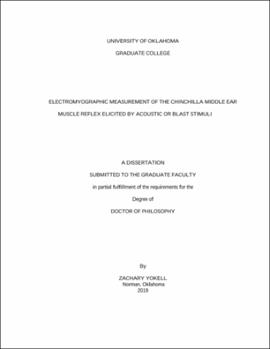| dc.description.abstract | Hearing damage is a widespread problem that can cause social isolation and reductions in quality of life. A wide range of conditions including extended exposure to noise or near-instantaneous exposure to blast overpressure can result in hearing damage. When the ear is exposed to potentially dangerous stimuli, the contraction of the stapedius muscle serves a protective function known as the middle ear muscle reflex (MEMR). Clinical measurements of the MEMR through acoustic reflex threshold (ART) testing are indirect and limited to determining the reflex’s presence or absence. Electromyography (EMG) provides direct measurements of a muscle’s activity, thereby expanding the parameters available for study. While chinchillas are an important model for hearing studies, there is not currently published EMG data on the chinchilla MEMR.
To improve the utility of chinchilla models in hearing research, a surgical method of EMG electrode insertion was developed. The MEMR response to pure tone acoustic stimuli over a range of frequencies (1, 2, 4, and 6 kHz) and amplitudes (50-110 dB) was characterized in n=14 animals. EMG results were compared to MEMR activation thresholds determined through ART testing, which found that EMG may be more sensitive than ART testing at registering a reflex activation. At 1 kHz the mean EMG-determined threshold was 63.6 ± 16.5 dB; at 2 kHz it was 70.0 ± 12.4 dB; at 4 kHz it was 71.4 ± 13.5 dB; and finally at 6 kHz it was 76.4 ± 13.9 dB. Latency time between stimulus onset and muscle activation at the MEMR threshold was determined to be, on average, 8.20 ± 1.10 at 1 kHz; 6.84 ± 1.41 at 2 kHz; 6.56 ± 1.62 at 4 kHz; and 5.86 ± 1.37 at 6 kHz. The latency decreased as stimulus amplitude increased at 1 kHz and 2 kHz, but did not significantly change at 4 kHz or 6 kHz.
After the surgical approach for EMG was well established, it was applied to animals that were subjected to blast conditions, a stimulus for which no EMG stapedius data exists in any animal model. Chinchillas (n=10) were exposed to a series of blasts with increasing intensities. The average latency time between blast overpressure onset and muscle activation was determined to be 4.75 ± 3.19 ms. As this is shorter than the time course of a blast event, this confirmed that the MEMR activates too slowly in chinchillas to provide a mitigative function against blast overpressure waves.
Finally, existing noise-induced hearing loss models in animals typically require days or weeks of stimulus. In order to accommodate the acute nature of invasive EMG studies, a one-hour and a two-hour model of hearing damage was developed based on 130 dB sound exposure. The MEMR thresholds and hearing levels of these chinchillas (n=8) were tested before and after noise exposure to quantify the resultant level of hearing damage. While there was not a statistically significant difference between the damage caused by the two exposure durations, the one-hour case caused an average of 65.1 dB shift in the animals’ hearing levels and 54.7 dB shift in MEMR activation levels. This model can be used to assess protective interventions in a single day of experimentation.
These studies have successfully used EMG as a technique to study the MEMR in chinchillas for the first time. There is now baseline data for the MEMR of chinchillas with normal hearing, which can serve as a point of comparison for future studies. The latency time between stimulus and MEMR activation was confirmed to be too high for protection from blast trauma to be likely. Finally, an acute hearing damage model was established, facilitating future testing of protective interventions. By expanding the understanding of the chinchilla MEMR, this work has strengthened chinchillas as a model for hearing. | en_US |
